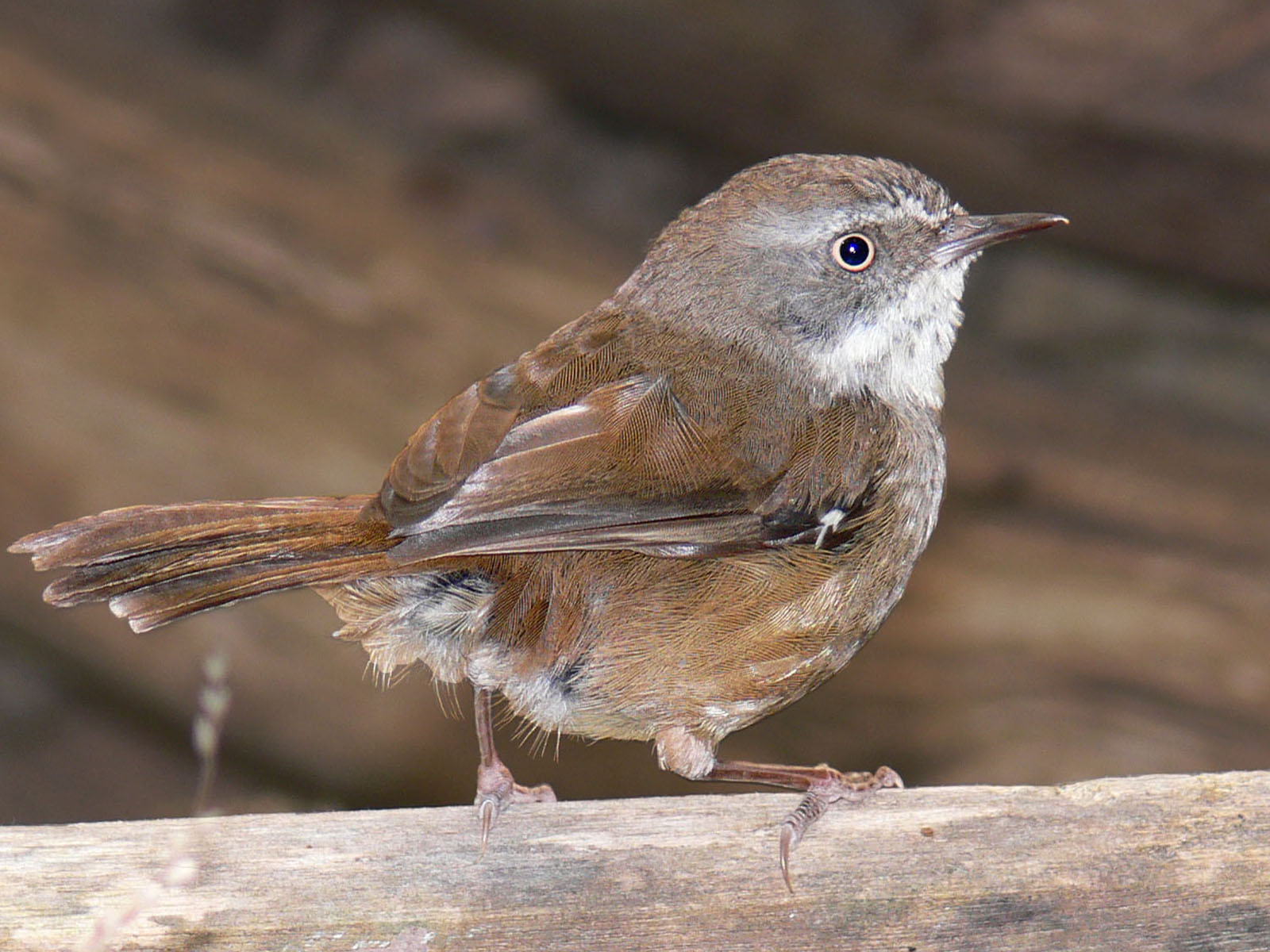- White-browed Scrubwren
Taxobox
name = White-browed Scrubwren
status = LC | status_system = IUCN3.1

regnum =Animal ia
phylum = Chordata
classis = Aves
ordo =Passeriformes
familia =Acanthizidae
genus = "Sericornis "
species = "S. frontalis"
binomial = "Sericornis frontalis"
binomial_authority = (Vigors & Horsfield, 1827) The White-browed Scrubwren ("Sericornis frontalis") is apasserine bird found in coastal areas ofAustralia . Placed in the familyPardalotidae in theSibley-Ahlquist taxonomy , this has met with opposition and indeed is now known to be wrong; they rather belong to the independent familyAcanthizidae .It is insectivorous and inhabits undergrowth, from which it rarely ventures, though can be found close to urban areas. It is 11-14 cm (5-6 in) long and predominantly brown in colour with prominent white brows and pale eyes, though the three individual subspecies vary widely. Found in small groups, it is
sedentary and engages incooperative breeding . The largerTasmanian Scrubwren is sometimes considered a subspecies of this species.Taxonomy
The White-browed Scrubwren was originally described by naturalists
Nicholas Aylward Vigors andThomas Horsfield in 1827. The specific epithet "frontalis" derived from theLatin "frons" "eyebrow". [cite book | last = Simpson | first = D.P. | title = Cassell's Latin Dictionary | publisher = Cassell Ltd. | date = 1979 | edition = 5 | location = London | pages = 883 | id = ISBN 0-304-52257-0] It is now divided into three subspecies:
*"S. f. frontalis", known as the White-browed Scrubwren, is found in coastal eastern Australia from the New South Wales-Queensland border round toAdelaide inSouth Australia .
*"S. f. laevigaster", known as the Buff-breasted Scrubwren, is found in coastal Queensland from the New South Wales border north to theAtherton Tableland .
*"S. f. maculatus", known as the Spotted Scrubwren, occurs in coastal southern Australia, from Kangaroo Island and Adelaide westwards to Shark Bay in Western Australia. it is known to intergrade with the nominate subspecies where their ranges overlap. [cite journal |last=Condon |first=HT |year=1951 |title=Notes on the birds of South Australia: occurrence, distribution and taxonomy |journal=J. Aust. Ornithol. |volume=20 |pages=26–68]"S. humilis", the
Tasmanian Scrubwren , is found inTasmania and Bass Strait islands and sometimes considered a subspecies of the White-browed Scrubwren. It is larger at 13.5 cm long and lays larger eggs.Description
Mainland birds measure 11.5 cm (4½ in) in length and olive brown upperparts (greyish brown in the spotted subspecies and dark brown in Tasmania), with prominent pale irises and a white brow. The throat is white with faint streaks in the subspecies "frontalis" and "laevigaster" and heavily spotted in "maculatus". Ear coverts are grey in "frontalis" and black in "laevigaster", and brownish in the other two subspecies. The underparts are pale, though buff in "laevigaster". The thin bill is black. The Females are duller overall. The call is a loud high-pitched "ts-cheer".cite book | author = Simpson K, Day N, Trusler P | title = Field Guide to the Birds of Australia | publisher = Viking O'Neil | date = 1993 | location = Ringwood, Victoria | pages = 392 | id = ISBN 0-670-90478-3]
Distribution and habitat
The species favours forested or scrubby areas with plentiful undergrowth, from which it rarely ventures. It is a common bird in bushland areas around Sydney. [cite book |last=Roberts |first=Peter |title=Birdwatcher's Guide to the Sydney Region |year=1993|pages=p. 132 |publisher=Kangaroo Press |location=Kenthurst, New South Wales |isbn=0-86417-565-5] It is sedentary.
Behaviour
Scrubwrens are predominantly insectivorous. They can be hard to spot but are very vocal and easy to localise. They occur in small groups of up to six birds and engage in cooperative breeding; namely that group members all help to feed and rear the young. [cite journal |last=Bell |first=HL |year=1983 |title=Cooperative Breeding by the White-browed Scrubwren "Sericornis frontalis" |journal=Emu |volume=82 (supplement) |pages= 315–16|url=http://www.publish.csiro.au/?act=view_file&file_id=MU9820315s.pdf |format=PDF |accessdate= 2007-10-21]
Reproduction
Breeding season is June or July to November or December, with the nest a domelike structure of dried grasses and leaves, sticks, bark and ferns and feathers for lining. It is placed near or on the ground in dense cover. A clutch of two or three 20 x 15 mm eggs is laid; they vary from brownish-violet to brownish-white in colour with darker spots or blotches. The Tasmanian Scrubwren lays larger eggs some 23 x 17 mm in dimensions. [cite book | last = Beruldsen | first = G | title = Australian Birds: Their Nests and Eggs | publisher = self | date = 2003 | location = Kenmore Hills, Qld | pages = p. 295-96 | doi = | id = ISBN 0-646-42798-9]
References
* Database entry includes justification for why this species is of least concern
External links
* [http://www.amonline.net.au/factsheets/white_browed_scrubwren.htm White-browed Scrubwren factsheet] Australian Museum online
* [http://www.birdsinbackyards.net/finder/display.cfm?id=6 Birds in Backyards - White-browed Scrubwren] - with call recording
Wikimedia Foundation. 2010.
